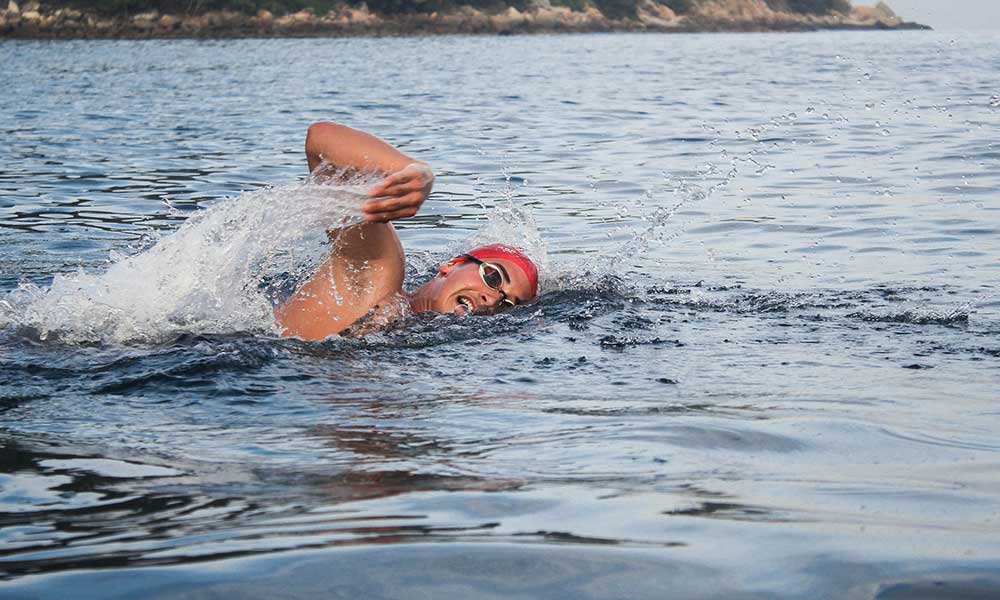Open water swimming is challenging but rewarding. It tests your body and your mind, but it also provides a wealth of health benefits.
What Is Open Water Swimming?
Open water swimming is a swimming discipline that occurs in open water, including lakes, rivers, and the ocean.
It often features in competitive events and is also practiced as a hobby and a way to improve strength and fitness.
Unlike pool swimming, there are no walls to push off and no lines to guide the swimmer. The water can also be cold, rough, and unpredictable.
As a result, open water swimming is a discipline all of its own and while it helps to be a strong pool swimmer, there is a sizable difference between pool swimming and open water swimming.
Techniques and Tips for Open Water Swimming
Swimming in the open water isn’t the same as going for a splash at your local pool.
There are numerous steps that must be taken and techniques that must be learned before you can have a safe open water swim.
These include:
Beach Starting and Exiting
Open water swimmers typically start from bridges or beaches.
When starting from the beach, they will either walk into the wake or do a dolphin dive, whereby they dive to the bottom, swim, and then launch themselves through the surface.
These techniques help to avoid incoming waves and allow for a strong and fast start.
Wearing the Right Gear
In competitive events, there are rules governing what swimmers are allowed to wear.
These rules can range from swim caps of a specific color to wetsuit type and guidelines surrounding support boats.
When there are no competitive guidelines, it’s important to err on the side of caution and make sure you are warm and protected throughout your swim.
The following equipment will help:
- A hydrophobic base layer for warmth
- A triathlon wetsuit of a suitable thickness
- A swim cap
- Cold-water gloves and socks
- Goggles
- A waterproof GPS watch
- Ear plugs
Adapting Strokes
Many pro swimmers use the front crawl or “freestyle” stroke as it’s a fast stroke.
However, you may need to adapt your stroke during your swim.
In choppy water, for instance, it makes more sense to perform short and shallow strokes.
Not only will changing your strokes help you as the water conditions change, but it will also take some off the strain off your shoulders.
Sighting
There are no lane lines in the open water and it’s hard to know if you’re swimming in the right direction.
It’s important to practice a technique known as “sighting”, whereby you regularly turn your head to look for landmarks.
In competitive swimming, there should be buoys in the water, but in poor visibility, you won’t be able to see them.
Instead, you need to triangulate your position by looking for two objects behind your intended destination.
When you sight these objects in the distance, you can determine whether or not you’re heading in the right direction based on whether those objects remain aligned.
How Do You Start Open Water Swimming?
The best way to practice open water swimming is to dive in and start swimming!
Going to your local pool isn’t quite the same and you need to get a feel for swimming in unpredictable open water.
Of course, that only applies if you’re a strong swimmer and you’re relatively fit.
If not, you’ll need to spend a few months in your local swimming pool honing your skills.
Some other things that will help you include:
- Take a friend with you in case you encounter any trouble in the water
- Wait for calmer and warmer waters
- Don’t push yourself too far in the beginning. Practice with limited runs
- Practice alternate breathing
- Improve your fitness and endurance
There are specific training plans that can help you, but as long as you’re a good swimmer with a strong pair of lungs and strong shoulders, you should be okay.
Is Open Water Swimming Dangerous?
It can be dangerous, and that’s why it’s important to stay within your limits, take a friend with you, and make sure you’re properly trained and prepared.
Practice in lakes, rivers, and the ocean; get a feel for the cold water and wind, and make sure you are adequately equipped (triathlon wetsuits, goggles, ear plugs).
Summary: Open Water vs Local Pool Swimming
There are huge differences between swimming in a local pool and tackling the great outdoors during open water season.
It’s colder, windier, more unpredictable, and you don’t have the benefits of accessible lifeguards, lane lines, heated water, and walls.
It doesn’t matter how good you are in the pool; you still need to practice on the open water.







